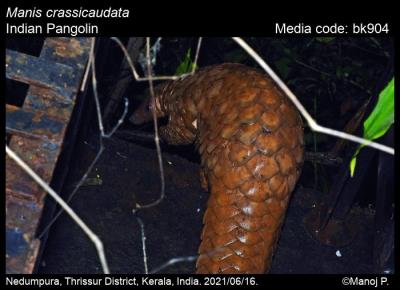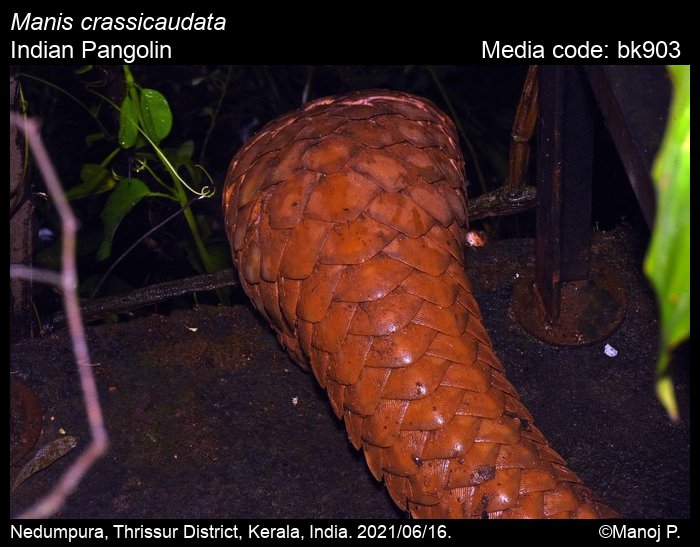
Subspecies in India
Also known as Thick-tailed Pangolin or Indian Scaly Anteater.![]() This species is listed as Endangered in the IUCN Red List of Threatened Species (https://www.iucnredlist.org/).
This species is listed as Endangered in the IUCN Red List of Threatened Species (https://www.iucnredlist.org/).
Photo Gallery and Species Biology
This species is native to Indian subcontinent and occurs mainly in India and Sri Lanka having a sporadic occurrence in Nepal, Pakistan and Bangladesh. It is a generalist in terms of its habitat preference and can be found in deciduous forests, semi-evergreen forests, secondary forests, grasslands, rocky habitats, and scrublands. It is adapted to live in dry as well as in wet conditions and can survive at high elevations up to 2300 m. It is a fossorial species, that prefers sandy and soft soil to make burrows. It is a solitary species that feeds largely on insects mainly ants and termites (hence the common name).
Conservation Status:![]() This species is listed as Endangered in the IUCN Red List of Threatened Species (https://www.iucnredlist.org/).
This species is listed as Endangered in the IUCN Red List of Threatened Species (https://www.iucnredlist.org/).
According to IUCN Red List assessment, population of this species is declining all over its range at an alarming rate. This species is recently listed as one of the most trafficked species in the world. There is little knonw about its popoulation owing to its shy and strict nocturnal habits which is vaguely estimated to be between 0.1 and 6 individuals per sq. km. It is estimated that about 80% of its global population is lost recently in one decade.
Major threat to its survival come from illegal trafficking. It is estimated that about 3,00,000 individuals were trafficked globally in last 20 years. Apart from hunting and trapping for its scales and meat, habitat loss and fragmentation due to various anthropogenic activities has contributed to its steady decline.
| State | Jan | Feb | Mar | Apr | May | Jun | Jul | Aug | Sep | Oct | Nov | Dec | No date |
|---|---|---|---|---|---|---|---|---|---|---|---|---|---|
| Andaman and Nicobar Islands | |||||||||||||
| Andhra Pradesh | |||||||||||||
| Arunachal Pradesh | |||||||||||||
| Assam | |||||||||||||
| Bihar | |||||||||||||
| Chandigarh | |||||||||||||
| Chhattisgarh | |||||||||||||
| Dadra & Nagar Haveli | |||||||||||||
| Daman & Diu | |||||||||||||
| Delhi | |||||||||||||
| Goa | |||||||||||||
| Gujarat | |||||||||||||
| Haryana | |||||||||||||
| Himachal Pradesh | |||||||||||||
| Jammu and Kashmir UT | |||||||||||||
| Jharkhand | |||||||||||||
| Karnataka | |||||||||||||
| Kerala | 1 | ||||||||||||
| Ladakh UT | |||||||||||||
| Lakshadweep | |||||||||||||
| Madhya Pradesh | |||||||||||||
| Maharashtra | |||||||||||||
| Manipur | |||||||||||||
| Meghalaya | |||||||||||||
| Mizoram | |||||||||||||
| Nagaland | |||||||||||||
| Odisha | |||||||||||||
| Paschimbanga | |||||||||||||
| Pondicherry | |||||||||||||
| Punjab | |||||||||||||
| Rajasthan | |||||||||||||
| Sikkim | |||||||||||||
| Tamil Nadu | |||||||||||||
| Telangana | |||||||||||||
| Tripura | |||||||||||||
| Uttar Pradesh | |||||||||||||
| Uttarakhand | |||||||||||||
| West Bengal | |||||||||||||
| Total | 1 |
Page citation
Anonymous 2025. Manis crassicaudata E. Geoffroy, 1803 – Indian Pangolin. In Bayani, A., R. Chakravarty, and K. Kunte (Editors) (Chief Editors). Butterflies of India, v. 1.13. Published by the Indian Foundation for Butterflies. URL: https://www.mammalsofindia.org/manis-crassicaudata, accessed 2025/12/25.



